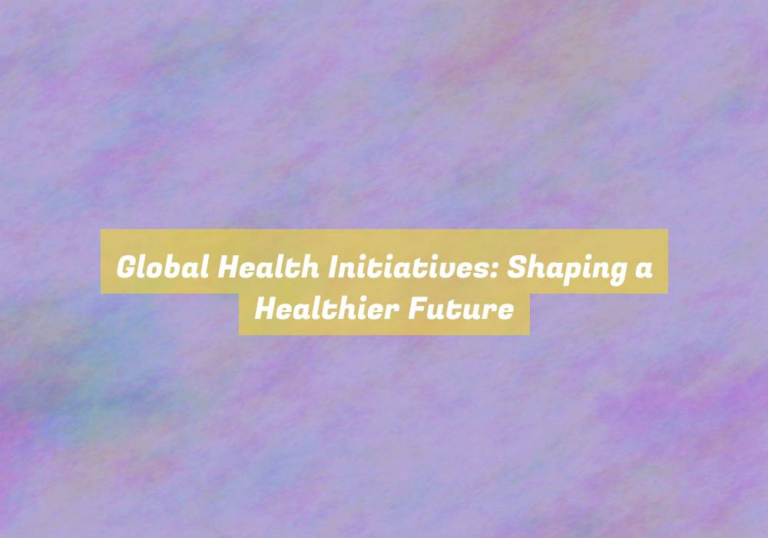Breaking Barriers: Access to Healthcare in Different Parts of the World
YouG??ve probably heard the saying, G??health is wealth,G?? and it couldnG??t be truer when considering the disparities in healthcare access around the world.
From economic and infrastructural challenges to cultural and social barriers, the obstacles people face in obtaining healthcare vary greatly depending on where they live.
However, there are also remarkable innovations and solutions being developed to address these issues. ItG??s fascinating to see how different parts of the world are tackling these barriers, and the impact these efforts could have on global health outcomes is truly intriguing.
Global Disparities in Healthcare Access
In some parts of the world, access to healthcare is significantly limited, creating global disparities that impact millions of people. This lack of access to healthcare services is a pressing issue that affects individuals and communities on a global scale. Many people in underserved regions face obstacles such as inadequate medical facilities, a shortage of healthcare professionals, and limited financial resources. As a result, they often struggle to receive timely and adequate medical care, leading to preventable illnesses and deaths.
Furthermore, disparities in healthcare access contribute to a cycle of poverty and poor health outcomes. Without proper medical attention, individuals may be unable to work or attend school, perpetuating economic instability and limiting opportunities for personal and societal growth. Additionally, the absence of essential healthcare services hinders the overall development of these communities, creating a ripple effect that impacts various aspects of daily life.
It is crucial to address these global disparities in healthcare access by implementing sustainable solutions that prioritize the well-being of all individuals. By advocating for improved healthcare infrastructure, increasing access to essential medications, and investing in healthcare education and training, itG??s possible to narrow the gap in healthcare access and provide better opportunities for individuals to lead healthier, more fulfilling lives.
Economic and Infrastructural Challenges
Addressing economic and infrastructural challenges is crucial for improving access to healthcare in underserved regions. In many parts of the world, limited financial resources and inadequate infrastructure pose significant barriers to healthcare. The high cost of medical services, medications, and insurance often prevents individuals from seeking necessary care. Additionally, poor transportation networks and a lack of healthcare facilities in rural areas make it difficult for people to access medical treatment. These economic and infrastructural challenges exacerbate health disparities, particularly for marginalized communities.
Insufficient funding for healthcare systems further perpetuates the lack of access to essential services. In low-income countries, public healthcare facilities often struggle with inadequate staffing, medical supplies, and equipment. This results in long wait times, substandard care, and limited treatment options for patients. Moreover, the absence of reliable electricity, clean water, and sanitation in some regions hinders the delivery of healthcare services. These challenges not only affect the quality of care but also impede efforts to prevent and control diseases.
Improving access to healthcare in underserved regions requires targeted investments in infrastructure, healthcare facilities, and workforce training. Governments, aid organizations, and private sector entities must collaborate to address these economic and infrastructural barriers effectively. By prioritizing these efforts, itG??s possible to enhance healthcare access and outcomes for vulnerable populations.
Cultural and Social Barriers
Overcoming economic and infrastructural challenges is essential for improving access to healthcare, but cultural and social barriers also significantly impact healthcare accessibility in underserved regions.
Cultural beliefs and practices often influence healthcare-seeking behavior. In some communities, traditional healers hold more sway than modern medical professionals, leading to delayed or inadequate treatment. Language barriers further exacerbate the issue, hampering effective communication between healthcare providers and patients. This can result in misunderstandings, misdiagnoses, and inappropriate treatment.
Moreover, social stigmas surrounding certain health conditions deter individuals from seeking care, perpetuating the cycle of poor health outcomes. Gender norms also play a role, with women in some cultures facing restricted autonomy in healthcare decision-making. Additionally, poverty and lack of education can contribute to social barriers, as individuals may not have the means or knowledge to navigate complex healthcare systems.
Tackling these cultural and social barriers necessitates a multifaceted approach, including community engagement, culturally sensitive healthcare services, and targeted educational initiatives to promote health-seeking behaviors. By addressing these barriers, we can work towards ensuring equitable access to healthcare for all.
Innovations and Solutions in Healthcare
To improve access to healthcare, embracing innovative solutions is crucial in addressing the diverse challenges faced by underserved communities around the world.
Telemedicine, for instance, has emerged as a game-changer, allowing individuals in remote areas to connect with healthcare providers through digital platforms. This has significantly reduced barriers to healthcare access for those who live far from medical facilities.
Additionally, mobile health clinics have proven effective in reaching marginalized populations, bringing essential medical services directly to their communities.
Moreover, wearable technology and health monitoring devices are empowering individuals to take charge of their health. These devices can track vital signs, detect abnormalities, and provide valuable data to healthcare professionals, leading to early interventions and improved health outcomes.
Furthermore, the use of drones for medical supply delivery in hard-to-reach areas has shown great promise in ensuring timely access to medications and emergency medical supplies.
Innovative solutions also involve revamping healthcare policies to better cater to the needs of underserved populations and investing in sustainable infrastructure to support the delivery of essential healthcare services.
Embracing these innovations is vital in breaking down barriers and improving healthcare access for all.
Conclusion
In conclusion, access to healthcare varies greatly around the world due to economic, infrastructural, cultural, and social barriers.
However, innovations and solutions are being developed to address these disparities.
ItG??s important to continue advocating for equitable healthcare access for all individuals, regardless of their location or background.
By working together, we can break down these barriers and ensure that everyone has the opportunity to receive the care they need.






